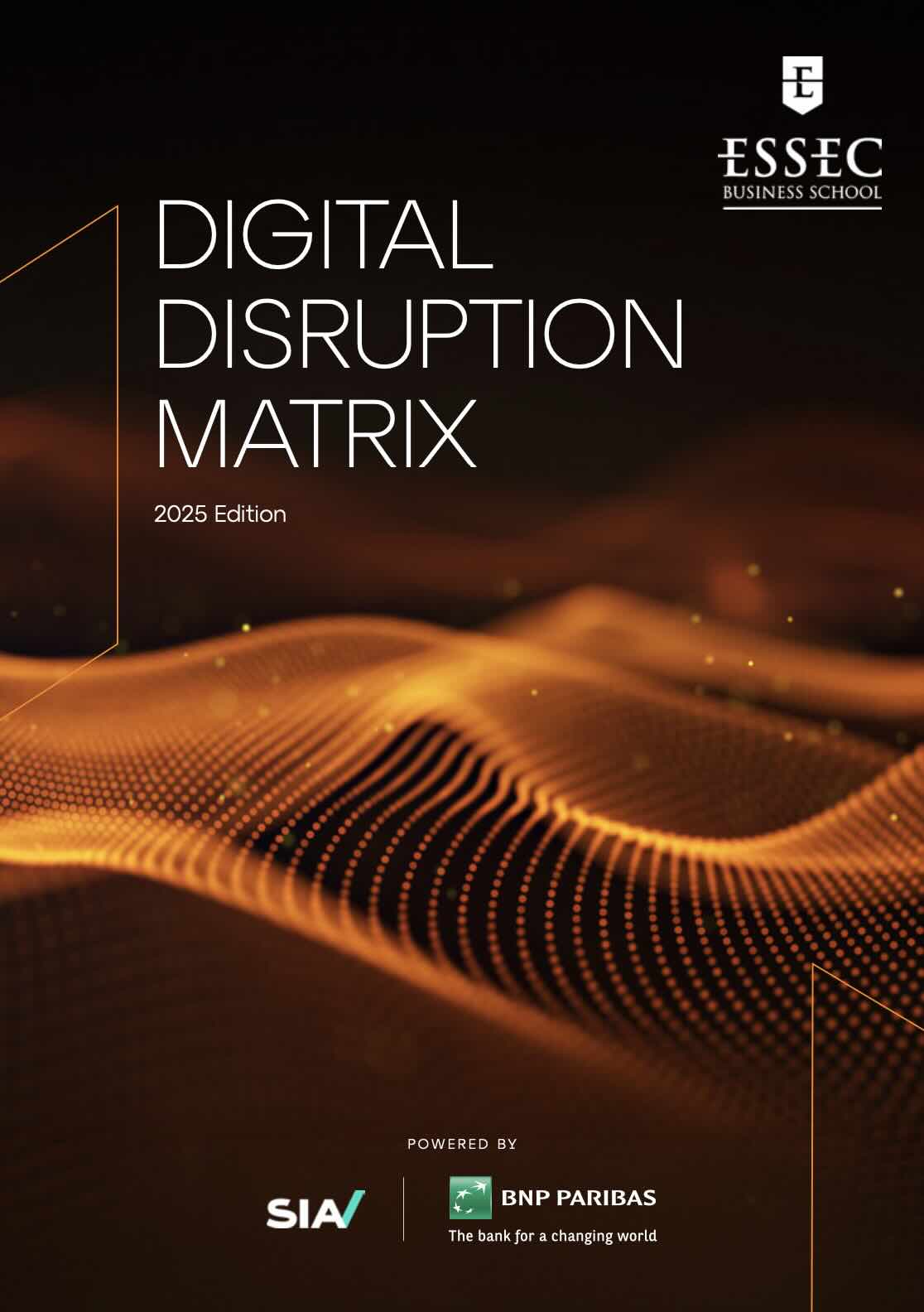
The Digital Disruption Chair presents
Digital Disruption Matrix
A yearly barometer designed for current and future global leaders who seek clarity on digital disruption through both data analysis and human insight.
Built on extensive research from industry reports, academic papers, patents, and expert insights, the Digital Disruption Matrix ranks the year's most disruptive digital technologies and highlights their real-world applications.
- Generative AI
- Descriptive AI
- Renewable Energy & Storage
- Quantum Computing
- Robotics & Automation
- Blockchain
Comprehensive analysis of emerging technologies
- Energy
- Materials
- Industrials
- FMCG
- Luxury/Retail
- Healthcare
- Financial Services
- Information Technology
- Communication Services
- Real Estate
- Auto/Transport
Cross-sector impact assessment
Features
Core Principles and Key Functionalities
Global Coverage
Our matrix captures global innovation trends across major economic regions, drawing from international patent filings, academic publications, and expert insights from varied geographies to provide a truly universal perspective on technological disruption.
Balanced Perspective
We meticulously balance technical promise with practical realities, synthesizing viewpoints from skeptics and enthusiasts alike to deliver nuanced insights that avoid both over-inflation of potential and excessive pessimism about digital disruption.
Data-Driven Methodology
Our matrix combines rigorous quantitative metrics (academic & patent publication volume and citations) with qualitative expert interviews and survey, creating a comprehensive methodology that reveals insights unavailable through either approach alone.
Key Functionalities
Interactive Heatmap
Navigate disruption visually
Explore the digital disruption landscape through our interactive heatmap, allowing you to visualize the disruption potential of technologies across industries with intuitive color-coding and dynamic filtering options.
Dual Perspective Views
Technology and industry lenses
Switch seamlessly between technology-first and industry-first views, allowing you to explore disruption from multiple angles and identify both cross-cutting technology trends and industry-specific disruption patterns.
Technology Rankings Visualization
Compare relative disruption scores
View technologies ranked by their disruption score with color-coded bars that enable quick visual comparison. Identify which technologies have the highest disruptive potential across sectors or within specific industries.
Publication Trends
Observe the evolution of publications
Visualize the cumulative growth of academic and patent publications over the last 5 years for each technology, revealing momentum patterns, acceleration points, and relative maturity of different technologies.
Sentiment Analysis
Get a sense of what experts think
Understand which technologies are viewed positively or negatively across different industries through our sentiment analysis visualization, revealing perception gaps and potential opportunities where technical promise meets industry realities.
Expert Views
From academia and industry
Access direct insights from leading academics and industry practitioners for each technology and sector. These expert perspectives contextualize data findings and provide unique insights.
Forewords
Welcome to the 2025 Digital Disruption Matrix
At a time of accelerating technological change,
The need for clear, data-driven insights into digital disruption has never been more pressing. The ESSEC Digital Disruption Matrix launches this year as an annual barometer designed to provide current and future global leaders with actionable insights on technological transformation.
This inaugural edition analyzes six transformative technologies selected by a college of 40 experts- Artificial Intelligence split into Descriptive and Generative AI, Quantum Computing, Robotics, Blockchain, and Renewable Energy Storage. Our research synthesizes multiple perspectives: trends in peer-reviewed publications and patent filings, analysis of 340 global industry reports, a quantitative survey of 1,000 professionals across sectors, and in-depth interviews with technology experts and industry leaders.
Our findings reveal a technological landscape where innovations are increasingly interconnected. Generative AI emerges with unprecedented momentum, while Energy Storage appears as the "hidden elephant in the room" – the potential bottleneck determining which innovations can scale sustainably. Quantum Computing shows promising specialized growth with significant implications for encryption, while Robotics evolves as AI simulations reduce development barriers. Despite reputational challenges, Blockchain continues developing toward an "invisible" infrastructure layer.
The resulting heatmap visualizes disruption's intensity across industries, revealing both expected patterns and surprising hotspots. Rather than claiming definitive authority, we position the Digital Disruption Matrix as a catalyst for strategic discussions about technological change. We invite readers to engage with these insights as starting points for deeper exploration in navigating an increasingly complex digital future.
Jérémy Beaufils
Executive Director
ESSEC Digital Disruption Chair
Prof. Jan Ondrus
Professor of Information Systems
ESSEC Digital Disruption Chair
ESSEC Digital Disruption Matrix 2025
Interactive analysis of six disruptive technologies reshaping eleven industry sectors—click to explore our dynamic dataset and reveal strategic insights across technologies, sectors, and their intersections.
| Descriptive AI | Generative AI | Quantum Computing | Blockchain | Robotics & Automation | Renewable Energy & Storage | |
|---|---|---|---|---|---|---|
Energy | View details | View details | View details | View details | View details | View details |
Materials | View details | View details | View details | View details | View details | View details |
Industrials | View details | View details | View details | View details | View details | View details |
FMCG | View details | View details | View details | View details | View details | View details |
Luxury/Retail | View details | View details | View details | View details | View details | View details |
Healthcare | View details | View details | View details | View details | View details | View details |
Financial Services | View details | View details | View details | View details | View details | View details |
Information Technology | View details | View details | View details | View details | View details | View details |
Communication Services | View details | View details | View details | View details | View details | View details |
Real Estate | View details | View details | View details | View details | View details | View details |
Auto/Transport | View details | View details | View details | View details | View details | View details |
This heatmatrix combines analysis from peer-reviewed publications, patent filings, industry reports, and expert interviews to visualize disruption intensity across sectors. Darker orange indicates higher disruption potential.
Data sourced from the 2025 Digital Disruption Matrix | ESSEC Digital Disruption Chair
Support of L'Atelier BNP Paribas for publications & patent data, powered by MARIO (https://atelier.net/mario). Courtesy of The Lens.
Key Findings 2025
Insights from our research
Descriptive AI
The essential foundation of digital transformation
Despite flashier technologies grabbing headlines, Descriptive AI remains the essential foundation powering digital transformation, with the Financial sector showing more positive sentiment (74.3%) than even the Tech sector itself (71.8%).
Generative AI
Financial sector embraces, Luxury sector skeptical
The Financial sector shows surprisingly high positive sentiment (82.2%) toward Generative AI, while Luxury Retail demonstrates unexpected skepticism with the highest negative sentiment (12.8%) despite potential creative applications.
Quantum Computing
Uncertainty and specialized applications
There's widespread uncertainty about Quantum's impact, with 30-43% neutral sentiment across sectors. Chemical industry applications, not cryptography, are likely to be the first real commercial use cases.
Blockchain
Lowest positive sentiment among technologies
Despite years of hype, Blockchain shows the lowest positive sentiment among all technologies (49-52%), revealing a shift from revolutionary promises to specialized infrastructure applications.
Robotics & Automation
Barriers to entry disappearing
AI simulation capabilities are obliterating historical barriers to robotics development, with Industrials showing remarkably high positive sentiment (86.9%) and very low negative sentiment across all sectors (<3%).
Renewable Energy/Storage
Energy storage is the key bottleneck
Energy storage emerges as the hidden bottleneck determining which technologies can scale sustainably, with extremely high positive sentiment (>75%) and near-zero negative sentiment across all sectors.
Expert Views
Insights from our industry and academic experts on emerging technologies
Our 2025 Technology Zoom
Quantum Computing
Why we chose Quantum Computing for our 2025 Zoom?
Ranking fourth in our Digital Disruption Matrix with a score of 32.47/100, quantum computing represents what we call a "frontier technology" - one that's still emerging yet holds tremendous transformative potential. Our matrix revealed what we've dubbed the "waiting for quantum" effect, with 40% of professionals across all sectors expressing neutral sentiment toward this technology, reflecting widespread uncertainty about when and how to prepare for its impact.
This ambiguity presents a fascinating challenge for business strategists for whom making accurate predictions and business decisions based solely on existing data is particularly difficult for a field this nascent. Patents and academic publications predominantly focus on cryptographic applications, but is this where the true business value lies?
Acknowledgments
This publication would not have been possible without the invaluable contributions and insights of numerous experts who generously shared their knowledge and perspectives. We extend our deepest gratitude to the following individuals who supported our research through their expertise, critical feedback, and collaborative spirit:
We are particularly grateful for the collaborative spirit that made this interdisciplinary exploration possible and would like to thank once more the Chair Partners BNP Paribas and SIA for their continued support.
Get the PDF
Download the Digital Disruption Matrix 2025 in PDF format.


